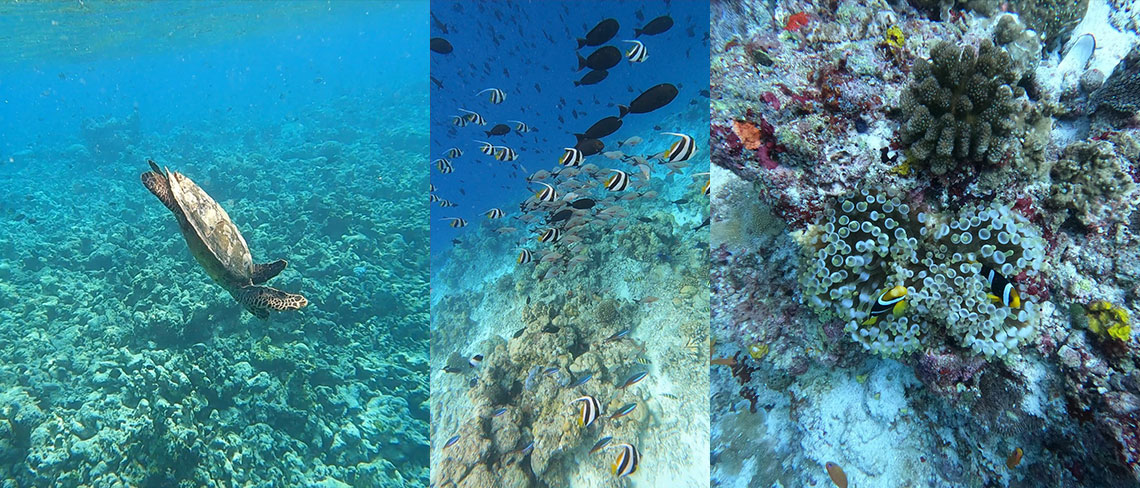
With mid and long-haul travel very much back on the cards this year and many of us longing for adventure after more than two years of Covid restrictions, resident Marine Biologist at Ozen Life Maadhoo provides a comprehensive guide for those who are looking to enjoy the deep blue in 2022.
“Despite the interruption of the past two years, underwater tourism remains ever popular”, says Oshin Joanna Christopher, resident Marine Biologist at Ozen Life Maadhoo, “but enjoying aquatic experiences responsibly is ever more important to both travellers and tourism providers.
“With constant innovation on the part of resorts, dive schools and operators, and increasing emphasis placed on both the education of guests and sustainability initiatives, the global dive offering is increasingly competitive.
“The basics remain the same, however. Knowledge of local habitats and wildlife, diver safety, and environmental responsibility are key, so if heading on a dive centric holiday, make sure you locate an accredited centre that will look out for both your welfare and that of the marine environment you’ll be exploring.”
Whether a diving beginner, wanting to introduce your children to the marine environment, or looking for some pointers after a Covid enforced diving hiatus, Oshin’s tips and insights are crucial to prepare for, get the most from, and ensure minimal impact during your diving holiday.
Pre-dive holiday preparation
Whether you’re headed to the Indian Ocean, Pacific, Caribbean, or the Red sea, It’s important to understand the marine environment that you are going to be immersed in.
- Do your research. There are several different types of underwater environments; seagrass meadows, coral reefs, wrecks, protected areas… Understanding the environment you’ll be diving or snorkelling in and the species you might encounter will make the experience much more exciting and will also help to calm any possible nerves or anxiety or prevent panic once in the water.
- Knowledge of a species’ behaviour and characteristics can protect you from harm. Triggerfish, for example, protect their eggs and can become aggressive if you get too close to their nests, whilst a fire coral can sting. Make sure you know when to keep a safe distance from particular species.
- Read up on different marine habitats to know what to look out for. Animals that live in coral, fish that live in anemones, average sizes, colouration, patterns of the marine wildlife, or whether they use camouflage… If there are lots of crevices where you are headed, you can try to spot lobsters, octopus, or giant moray eels.
- Whether diving or snorkelling, it is very important to stay buoyant with minimal effort. If you haven’t been swimming for a while, do some practice ahead of your trip to ensure confidence.
- Divers should get equipment serviced prior to holiday and obtain specialist diving Insurance.
Packing for your marine-centric holiday
- Reef-friendly sunscreen, hats or caps, sunglasses, insect repellent, sea sickness treatments.
- Reduce single use plastics by taking a reusable water bottle.
- A user-friendly underwater camera or Go Pro is advisable to document your diving/snorkelling experience.
- Pack extra swimsuits and rash guards.
- You’ll be more comfortable using your own mask and fins, so it’s worth making space for these in your luggage.
- Don’t forget your local Fish ID book or guide for the area you are visiting.
The importance of protecting coral
- Coral reefs make up a fragile ecosystem. They are the biodiversity hotspots and building blocks of the marine environment, so it’s important to prevent damage to reefs from pollutants and man-made stressors. Covering less than 1% of the ocean, coral reefs are home to a huge 25% of all marine life so they need to be understood, respected and protected.
- Corals, coral reefs, and their associated structures create habitats for many fish species, providing both a source of food and shelter and acting as nurseries for many fish young.
- They also fulfil a role as natural barriers against tsunamis, floods and erosion, playing a vital role in coastal protection.
- With over 200 million people living along coastlines globally, corals also provide a critical source of livelihood and food and generate billions in revenue to support local communities thanks to the tourism industry.
- New research has recently identified a medicinal use for coral. The properties of coral skeletons have been found to be compatible with natural bone and are now being used to treat bone regeneration.
How to behave in the water
- Never touch or chase marine wildlife. Stressing or scaring marine life can cause defence responses that use up their energy and can significantly reduce lifespan or even endanger their chances of survival.
- Stay off the sea/ocean bed. A number of marine creatures, such as eels or stingrays, dwell in the sand to camouflage themselves, so avoid disturbing the seabed and be careful with your fins.
- Do not feed. Fish and marine mammals are not accustomed to eating human food, which can be harmful to their organisms and to their environment. Be especially careful with sharks, rays, moray eels, and turtles as hand feeding them can promote unnatural behaviours.
- Do not litter. Plastic and all other non-biodegradable material can linger in the ocean for many years and can entangle or choke marine animals. Turtles, for example, have spiny projections in their throats, which cause plastics to get stuck in their throats which can suffocate them.
Experiences with ocean giants
When looking for or getting up close to any bigger sea life – Rays, whales, sharks or dolphins – be mindful:
- Do your homework. Read up on the animal’s behaviour and blind spots. For example, if diving with manta rays, you should know to never block their paths. Approach from the side only or it could alter their intended migration route or scare them away from their feeding site.
- Enter the water quietly. Try to minimise splashing to avoid scaring animals away.
- Keep your distance. Aim to maintain a three-metre distance from the animal to minimise any stress.
- Respect. Remember that these are wild animals, and you are sharing their habitat so it’s important to respect them and make as little impact as possible during your immersion.
Introducing children to diving or snorkelling
- Education is key. Help to raise children’s awareness and spark their curiosity of the ocean and the experience of snorkelling or diving ahead of time, using videos, movies and kid-friendly documentaries such as Blue Planet, Puff: Wonders of the reef, or My Octopus teacher. Fish ID books and charts are also helpful to identify sea life and create anticipation.
- Hands on activities. Head to the coast to take children rock pooling and to explore beaches and harbours for fish, crustaceans, algae and other inter-tidal marine life (blenny, goby and triplefins). Allow children to get comfortable being in and around the sea.
- Swimming. Teaching children how to swim and feel confident and comfortable in the water is imperative ahead of any beach holiday, but especially in preparation for a dive or snorkelling trip.
- Maturity. Parents will be the best placed to make a judgement call as to whether a child is ready to learn how to snorkel or dive. Whilst the recommended minimum age for diving is 10, and some children are introduced to snorkelling as young as two years old, each child is different. It’s important to consider how your child might react in an emergency and whether they have the emotional and physical maturity to deal with potential stressful or simply exciting encounters underwater.
- Bubble Maker. The PADI bubble maker programme is one of the best ways to get your child to step into the world of scuba diving before doing an Open Water certification.
Underwater photography
- Choosing a camera. There are many different camera types, brands and models. Prices also vary significantly, so do your research according to your needs and quality requirements. To have control over exposure and ambient light, you ideally need a camera that offers full manual mode. The housing is important – does it provide access to all the camera controls and features? Make sure your camera has good Macro mode for close ups, and adequate external flash.
- Buoyancy check. Master your buoyancy – you can do a weight check at the dive centre. The ability to stay neutrally buoyant is key to allow you to focus and control your camera on the wildlife or seascapes without having to constantly try to stay afloat.
- Filters. Depending on the depth and camera type, colour is lost as we dive deeper. Opt for Magenta filters for shallow water snorkels or dives and Red filters for deeper than 5 metres.
- Lights. We lose light as we go deeper, so investing is lights (strobes or video light) will significantly increase the quality of the photo or video greatly.
- Shoot upwards. Always shoot upwards to get more light into the picture.
- Practice. Keep practicing; photography, like any other art requires practice to make perfect.
- Modes. Familiarise yourself with the different camera modes and always shoot in RAW to be able to later import and edit in Photoshop.
- Black and white. If the photo is blurry, don’t discard it, try the monochrome settings; B&W will generally shed a striking perspective on many photos.
Food & drink recommendations for divers
- High energy foods. Scuba diving burns a lot of calories, so a good balanced breakfast, but without heavy fats and oils is recommended.
- Carbs and proteins. Opt for slow-release energy foods such as eggs, cereal, fruits, bagels, yogurt or toast to maximise body temperature and stamina throughout the dive.
- Eat light. A heavy breakfast can make you feel bloated and uneasy during a dive.
- Eat early. Eat at least one hour before you go diving to allow for digestion.
- Hydrate. Make sure you drink plenty of fresh juices, water, or even energy drinks to avoid dehydration before and after immersion but be careful not to drink so much that you feel bloated.
- Avoid acidic foods. Like oily foods, citric fruits can cause acid reflux so are best avoided.
- During Surface intervals. Have high-carb foods such as granola bars, nuts, dried fruit, bananas, cookies and yogurt to boost energy levels ahead of your next dive.
- Lunch & dinner. It’s advisable to enjoy easily digestible foods ahead of and after an immersion. Opt for fish, spinach, and brown rice for example, as opposed to meat, pasta or pulses.
Sun protection
It’s very easy to get sunburnt on a boat and whilst on the surface of the water. Don’t forget sun protection:
- Prevent. The sun rays are at their peak between 12pm to 3pm. Try to avoid direct exposure to the sun during these hours. Use umbrellas, sunglasses and hats; especially if on a boat.
- Wait. Wait at least 15 to 20 minutes after applying sunscreen to let the sunscreen absorb sufficiently.
- Apply everywhere. Don’t forget to apply sunscreen on lips, neck, feet, and the back of your hands to reduce risk of sunburn.
- SPF. Use an SPF of at least 30.
- Reef Safe. Studies show that chemicals such as oxybenzone can damage coral health and be toxic to fish so use reef safe, mineral based sunscreen.
Oshin Joanna Christopher is an experienced Marine Biologist with a passion for sustainability and biodiversity.
In her residency at OZEN LIFE MAADHOO, she manages coral restoration projects, runs marine awareness programmes for guests, conducts training for resort staff, monitors all IUCN Redlist species, fish biodiversity, coral health, substrate composition changes in the lagoon and reef, accompanies guests on snorkels to showcase the coral projects, and carries out lagoon and reef clean-ups on both guest and staff island.
OZEN LIFE MAADHOO is deeply committed to its coral restoration program, offering coral tree planting events, coral line sponsorships and carrying out lagoon cleans with the aim of regenerating and enriching Maadhoo island’s ecosystem. The resort also runs a twice weekly coral awareness programme for guests, covering what coral is, the threats, how coral reefs form, why we should protect corals and outlining the coral restoration plans for the island. With nurse shark and manta ray season approaching (June), the OZEN LIFE MAADHOO dive centre provides dedicated dive and snorkel sessions to enjoy these creatures in their natural habitat.
Beyond marine conservation efforts, the resort incorporates sustainable practices into all operations, ranging from procurement to solar energy. OZEN LIFE MAADHOO is also certified by Green Globe, an international standard for sustainable tourism.
-Ends-
For further press information, please contact:
Chloe Hernandez | Julie Aguilera
Rooster PR
T: +44 (0)203 440 8930
E: [email protected]
About THE OZEN COLLECTION
THE OZEN COLLECTION creates timeless sanctuaries that exude tranquillity and inspiration. An abundance of sophisticated experiences seamlessly blended with a grand sense of space and design, tailored wellness journeys, and an enriching culture set apart the brand’s two resorts in the Maldives.
OZEN LIFE MAADHOO, the first resort under this brand, opened in July 2016. THE OZEN COLLECTION’s success story continues in the Maldives with the addition of OZEN RESERVE BOLIFUSHI, launched in December 2020. OZEN SECLUDED TANGALLE takes the brand to the south coast of Sri Lanka and is scheduled to be launched in 2023.
THE OZEN COLLECTION
OZEN LIFE MAADHOO
OZEN RESERVE BOLIFUSHI






